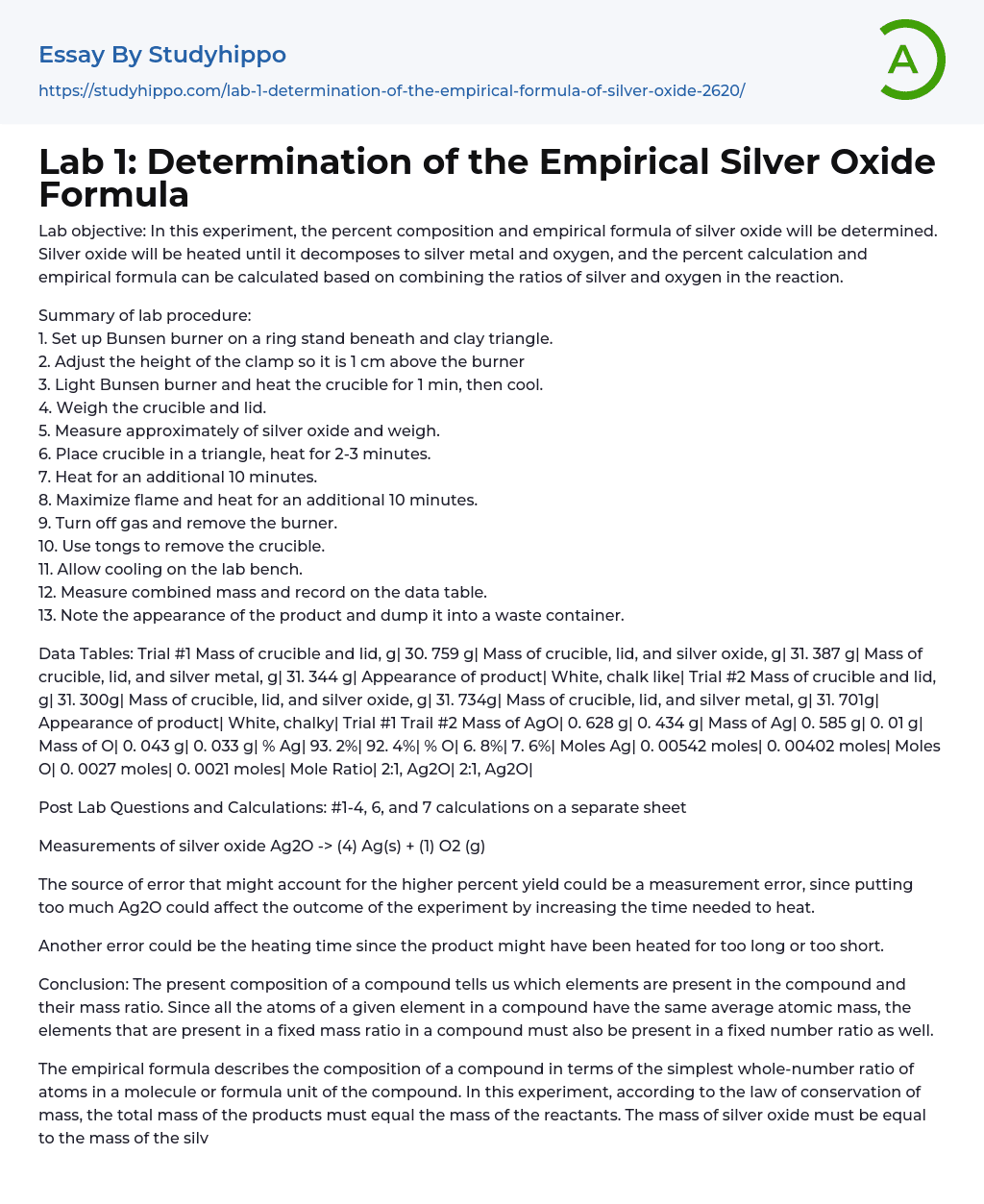

Determination of the Empirical Silver Oxide Formula Essay Example
Lab objective: In this experiment, the percent composition and empirical formula of silver oxide will be determined. Silver oxide will be heated until it decomposes to silver metal and oxygen, and the percent calculation and empirical formula can be calculated based on combining the ratios of silver and oxygen in the reaction.
Summary of lab procedure:
- Set up Bunsen burner on a ring stand beneath and clay triangle.
- Adjust the height of the clamp so it is 1 cm above the burner
- Light Bunsen burner and heat the crucible for 1 min, then cool.
- Weigh the crucible and lid.
- Measure approximately of silver oxide and weigh.
- Place crucible in a triangle, heat for 2-3 minutes.
- Heat for an additional 10 minutes.
- Maximize flame and heat for an additional 10 minutes.
- Use tongs to remove the crucible.
- Allow cooling on the lab bench.
- Measure combined mass and record on the data table.
- Note the appearance of the product and dump it into a waste container.
i>Turn off gas and remove the burner.
Measurements of silver oxide Ag2O -> (4) Ag(s) + (1) O2 (g) The source of error that might account for the higher percent yield could be a measurement error, since putting too much Ag2O could affect the outcome of the experiment by increasing the time needed to heat. Another error could be the heating time since the product might have been heated for too long or too short. Conclusion: The present composition of a compound tells us which elements are present in the compound and their mass ratio. Since all the atoms of a given element in a compound have the same average atomic mass, the elements that ar
present in a fixed mass ratio in a compound must also be present in a fixed number ratio as well.
The empirical formula describes the composition of a compound in terms of the simplest whole-number ratio of atoms in a molecule or formula unit of the compound. In this experiment, according to the law of conservation of mass, the total mass of the products must equal the mass of the reactants. The mass of silver oxide must be equal to the mass of the silver meal along with the mass of the evaporated oxygen. Therefore, that was how the percent composition of silver oxide was figured out.
- John Locke essays
- 9/11 essays
- A Good Teacher essays
- A Healthy Diet essays
- A Modest Proposal essays
- A&P essays
- Academic Achievement essays
- Achievement essays
- Achieving goals essays
- Admission essays
- Advantages And Disadvantages Of Internet essays
- Alcoholic drinks essays
- Ammonia essays
- Analytical essays
- Ancient Olympic Games essays
- APA essays
- Arabian Peninsula essays
- Argument essays
- Argumentative essays
- Art essays
- Atlantic Ocean essays
- Auto-ethnography essays
- Autobiography essays
- Ballad essays
- Batman essays
- Binge Eating essays
- Black Power Movement essays
- Blogger essays
- Body Mass Index essays
- Book I Want a Wife essays
- Boycott essays
- Breastfeeding essays
- Bulimia Nervosa essays
- Business essays
- Business Process essays
- Canterbury essays
- Carbonate essays
- Catalina de Erauso essays
- Cause and Effect essays
- Cesar Chavez essays
- Character Analysis essays
- Chemical Compound essays
- Chemical Element essays
- Chemical Substance essays
- Cherokee essays
- Cherry essays
- Childhood Obesity essays
- Chlorine essays
- Classification essays
- Cognitive Science essays



